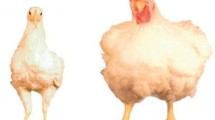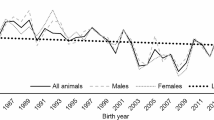Abstract
The aims of this study was to evaluate inbreeding effects for growth rate (average daily gain from hatch to 8 weeks of age (ADG1–8), average daily gain from hatch to 12 weeks of age (ADG1–12), average daily gain from 8 weeks of age to 12 weeks (ADG8–12), average daily gain from hatch to sex maturity (ADG1-SM), average daily gain from 8 weeks of age to sex maturity (ADG8-SM), average daily gain from 12 weeks to sex maturity (ADG12-SM), and Kleiber ratios (KR1–8, KR1–12, KR8–12) in Mazandaran native chickens. The data set of 82,446 pedigreed individuals over 21 generations was analyzed. All individuals were grouped into three classes based on the inbreeding coefficient: First class contained non-inbred birds (F = 0) and second and third classes contained inbred individuals (0 < F ≤ 5% and F > 5%, respectively). The effects of inbreeding coefficient on the studied traits were estimated by the restricted maximum likelihood method (REML) applying the WOMBAT software and fitting individual increase in inbreeding coefficient (ΔFi) of birds as linear covariates under 6 different animal models. ADG8-SM and ADG12-SM increased non-significantly by 0.003 and 0.005 g, respectively, due to 1% increase in ΔFi, while ADG1–8, ADG1–12, ADG8–12, ADG1-SM, KR1–8, and KR1–12 decreased (P < 0.001), respectively, by 0.012 g, 0.011 g, 0.010 g, 0.014 g, 0.003 g, and 0.002 g. Also, KR8–12 non-significantly decreased by 0.001 g. Estimates of direct heritability of traits based on the most appropriate models ranged from 0.05 (KR8–12) to 0.26 (ADG12-SM). Results showed that it is important to regularly analyze inbreeding level in the herd in an attempt to prevent the reduction of performance.
Similar content being viewed by others
References
Akaike, H., 1974. A new look at the statistical model identification. IEEE, Trans. Automatic Control, 19, 716-723.
Barczak, E., Wolc, A., Wojtowski, J., Slosarz, P. and Szwaczkowski, T., 2009. Inbreeding and inbreeding depression on body weight in sheep. Journal of Animal Feed Science, 18, 42-50.
Dana, N., Vander Waaij E.H. and Van Arendonk, J.M., 2011. Genetic and phenotypic parameter estimates for body weights and egg production in Horro chicken of Ethiopia. Tropical Animal Health and Production. 43, 21-28.
De Donato, M., Manrique, R., Ramirez, R., Mayer, L. and Howell, C., 2005. Mass selection and inbreeding effects on a cultivated strain of Penaeus (Litopenaeus) vannamei in Venezuela. Aquaculture, 247, 159-167.
Falconer, D.S. and Mackay, T.F.C., 1996. Introduction to Quantitative Genetics. 4th ed. ongman, Harlow, UK.
Fanatico, A.C., Owens, C.M. and Emmert, J.L., 2009. Organic poultry production in the United States: Broilers. Journal of Applied Poultry Research, 18, 355–366.
Gholizadeh, M., 2017. Population structure of Mazandaran native fowls using pedigree analysis. Tropical Animal Health and Production, 2017. 49, 561-567.
González-Recio, O., López de Maturana, E., Gutiérrez, J.P., 2007. Inbreeding depression on female fertility and calving ease in Spanish dairy cattle. Journal of Dairy Science, 90, 5744-5752.
Gutiérrez, J.P. and Goyache, F., 2005. A note on ENDOG: a computer program for analyzing pedigree information. Journal of Animal Breeding and Genetics, 122, 172–176.
Gutiérrez, J.P., Cervantes, I., Goyache, F. 2009. Improving the estimation of realized effective population sizes in farm animals. Journal of Animal Breeding and Genetics,126, 327-32.
Kamali, M.A., Ghorbani, S.H., Moradi Sharbabak, M. and Zamiri, M.J., 2007. Heritabilities and genetic correlations of economic traits in Iranian native fowl and estimated genetic trend and inbreeding coefficients. British Poultry Science, 48, 443–448.
Manjula, P., Park, H.B., Seo, D., Choi, N., Jin, S., Ahn, S.J., Heo, K.N., Kang, B.S. and Lee, J.H., 2018. Estimation of heritability and genetic correlation of body weight gain and growth curve parameters in Korean native chicken. Asian-Australasian Journal of Animal Science, 31, 26-31.
Mehrabani-Yeganeh, H., Gibson, J.P. and Schaeffer, L.R., 2000. Including coeffi cients of inbreeding in BLUP evaluation and its effect on response to selection. Journal of Animaal Breeding and Genetics, 117, 145-151
Meyer, K., 2007. WOMBAT – A tool for mixed model analyses in quantitative genetics by restricted maximum likelihood (REML). Journal of Zhejiang University Science B, 8: 815–821.
Pham, M.H., Tran, X.H., Berthouly-Salazar, C., Tixier-Boichard, M., Chen, C.F. and Lee, Y.P., 2016. Monitoring of genetic diversity in Taiwan conserved chickens assessed by pedigree and molecular data. Livestock Science, 184: 85–91.
Rahmanian, A., Hafezian, H., Rahimi, G.H., Farhadi, A. and Baneh, H., 2015. Inbreeding depression for economically important traits of Mazandaran native fowls. British Poultry Science, 56, 22-9.
Sargolzaei, M., Iwaisaki, H. and Colleau, J.J., 2006. CFC: a tool for monitoring genetic diversity. Proceedings of the 8th World Congress on Genetics Applied to Livestock Production, Belo Horizonte, Minas Gerais, Brazil. pp. 27–28.
SAS, 2009. SAS User’s Guide: Statistics, Release 9.2. SAS Inst. Inc., Cary, NC.
Schmidt, G.S. and Figueiredo E.A.P., 2005. Selection for Reproductive Traits in White Egg Stock Using Independent Culling Levels. Brazilian Journal of Poultry Science, 7, 231–235.
Szwaczkowski, T., Cywa-Benko K. and Wężyk, S., 2003. A note on inbreeding effect on productive and reproductive traits in laying hens. Animal Science Papers and Reports, 21 2, 121-129.
Tixier-Boichard, M., Bordas, A. and Rognon, X., 2009. Characterisation and monitoring of poultry genetic resources. Worlds Poultry Science Journal, 65, 272–285.
Acknowledgements
The authors sincerely thank the Mazandaran native fowl breeding station’s staffs for providing the data set used in this study.
Author information
Authors and Affiliations
Corresponding author
Ethics declarations
Conflict of interest
The authors declare that they have no conflict of interest.
Additional information
Publisher’s note
Springer Nature remains neutral with regard to jurisdictional claims in published maps and institutional affiliations.
Rights and permissions
About this article
Cite this article
Yousefi, B., Gholizadeh, M. & Hafezian, H. Quantifying the effect of inbreeding on average daily gain and Kleiber ratio in Mazandaran native chickens. Trop Anim Health Prod 52, 3217–3223 (2020). https://doi.org/10.1007/s11250-020-02347-x
Received:
Accepted:
Published:
Issue Date:
DOI: https://doi.org/10.1007/s11250-020-02347-x




